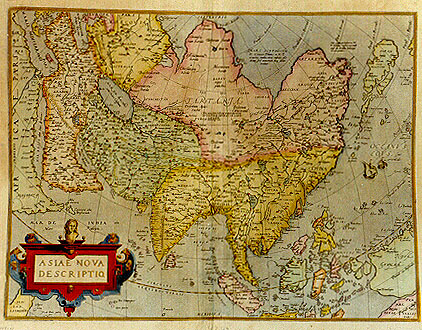Cartographica Neerlandica Background for Ortelius Map No. 6

Title: ASIAE NOVA | DESCRIPTIO [A new depiction of Asia] (lower left corner, faintly visible:) "Cum priuilegio". [With privilege]. (Upper right:) "MARE SCYTHICVM | & TABIN. Plinius, & | M.P. Venetus multas in eo | insulas e▀e dicunt, sed nu:|merum neq.sitű tradunt. [Scythian sea and Tabin. Plinius and Mr. P. Venetus say that there are many islands here, but they do not mention their number nor their location.] (Upper centre:) "HIC MAGNUS CHAM TARTARO|RVM ET CHATAIAE IMPERATOR |LONGE LATE:|QVE DOMINA:|TVR". [Here the great Cham, the chief who rules far and wide over the Tartars and Chataiae]. (Centre to the right:) "Hic Rhabarbarű tanta copia | prouenit vt hinc ad §es | orbis partes vehatur". [Here one finds medicinal rhubarb in such quantities that it is exported to all parts of the world.] Upper right:) "Hic vasa porcellina | dicta finguntur". [Here vases of so-called porcelain are made.] (Upper right:) "Pons marmo:|reus 300 pa▀:" [Here is a bridge made of marble, 300 strides long.] ((Top right:) "Vrbs Quinsai habet vt | M.P.Venetus refert 100 | mill.pa▀: in circuitu | habetq. 12000 pontes" [The city of Quinsai, according to Mr. P. Venetus, is 100 miles in circumference, and has 12000 bridges.]
Plate size: 374 x 488 mm
Scale: 1 : 28,000,000
Identification number: Ort 6 (Koeman/Meurer: 3; Karrow: 1/8, van der Krogt AN: 8000:31A)
Occurrence in Theatrum editions and page number:
1570L(A)3 (100 copies printed) (last line, centred like two lines above it: iori Tabula ante tres Annos edidimus.),
1570L(BC)3 (225 copies printed) (last line, centred like two lines above it: Tabula ante tres Annos edidimus.)
1571L3 (275 copies printed) (last line, centred like three lines above it: Tabula ante tres Annos edidimus.),
1571D/1573D3 (350 copies printed) (last line, centred like two lines above it, in Gothic script: mette Magellanica is.),
1572/1574F3 (225 copies printed) (last line, centred like 2 lines above it, in cursive script like the entire text: "ou terre ferme auec la Magellanique."),
1572G3Koler (pasted over p.3 of a 1570L edition; few copies printed) (last line, in Gothic script: uarchŠ des Jesuiten Epistel/Und wir haben auch in einer grossen Tabul beschriben/und vor dreyen Jarn in Druck verfertiget.),
1572/1573G3 (225 copies printed) (last line, italic like the entire text, centred like 3 lines above it: "es ein Insel oder vastlandt mit Magellanica ist."),
1573L(AB)3 (80 copies printed) (Version A has 4th line from the bottom ending with cogno- ; version B has 4th line from the bottom ending with cog- ; last line in both versions, centred like two lines above it: iori Tabula ante tres annos edidimus.),
most 1574L3 (175 copies printed) (large page number, 11 mm, last line, centred like 2 lines above it: nem in maiori Tabula ante tres annos edidimus.).
Approximate number of copies printed: 1675.
States: 6.1 only.
Cartographic sources: Ortelius' own 1567 wall map of Asia, based in turn on work by Gastaldi and Albufeda (Karrow 1/4, 30/85, 30/91 and 30/92, p. 2-3, 231-232, 238-240, Meurer p. 21).
References: G.R. Tibbets, Arabia in Early Maps, Falcon-Oleander, 1978, map 34, p. 48. On Ortelius wall map of Asia, see G. Schilder "The Wall Maps by Abraham Ortelius" p. 93-124 and M. Heintz & C. Reiter "AsiŠ Descriptio and the Judgment Day Painting", p. 125-132, both in: Van den Broecke, van der Krogt and Meurer (eds) "Abraham Ortelius and the First Atlas", HES Publishers, 1998. T. Suarez, Early Mapping of South-East Asia, Periplus, 1999, p. 164-170
Remarks: This plate is succeeded by a very similar Asia plate, Ort 7 in the course of 1574. Therefore, this plate is much less common than its successor, Ort 7. "La Farfana" in the upper right corner in the sea has lower case "farfana" in plate 7, but capital "Farfana" in the present first plate. The town "Ara" above "Aden" has disappeared in plate 7.
For questions/comments concerning this page, please e-mail info@orteliusmaps.com.